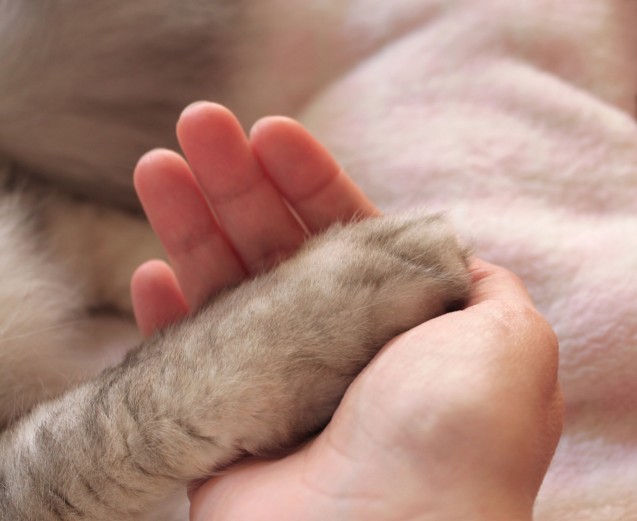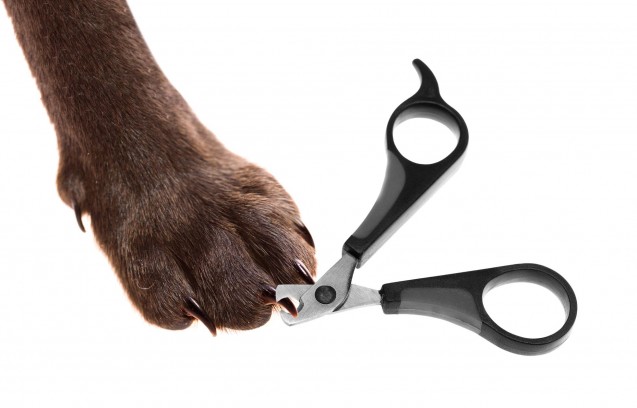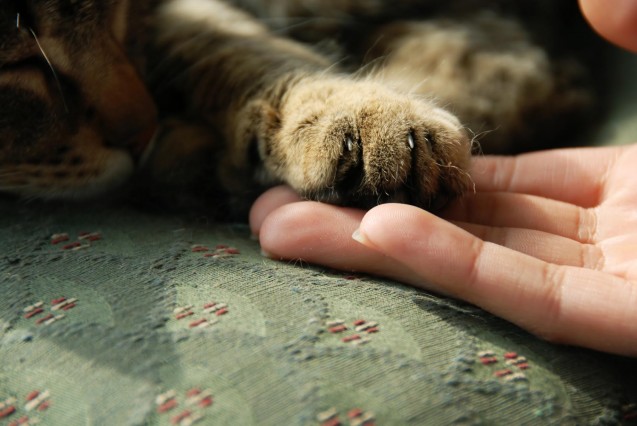Anal glands are not something pet owners want to talk or think about, but they are something they need to know about.
Anal sacs, or glands, are located on both sides and slightly below your dog or cat’s anus. They produce fluid with a distinctive odor. Healthy anal glands express (empty) on their own when your pet has a bowel movement. However, some anal glands do not express on their own sometimes. This can be due to a variety of reasons, including inherited malformations, or poor-quality foods which can cause poor-quality bowel movements.
This can become a serious health issues for your dog or cat, because if those anal sacs do not empty properly on their own, they can become impacted. This can lead to difficult or painful bowel movements, which can lead to potential infections or abscesses.
The most obvious way your dog or cat will tell you that his or her anal glands are bothering him is that they will bite or lick at their anal area, or scoot across the floor in their own attempt to express the glands. The fluid in the anal sacs is extremely stinky, and you will know if your pet has expressed his or her anal glands on their own when you smell it.
If your pet is showing signs of being impacted, or if he or she has a history of it, it is best to have a professional express the anal glands for you. This can be done at some groomers, or at a veterinary clinic.
You can also ask your veterinarian to recommend a high-fiber diet to create stronger stools, which may lead to some relief. However, if that does not work and your dog or cat has repeated infections or abscesses, the anal glands may need to be removed.
See how anal glands are expressed by the certified veterinary technicians of American Animal Hospital in our How to Express Your Dog’s Anal Glands video here
More
Your pet means the world to you, and facing the decision on when it’s time to euthanize him or her is a very stressful, emotional time. There is no right answer to “when it is time” – but there are some guiding factors to help you make this difficult decision.
Dr. Melissa Heenan discusses this sad but important topic in the following video. She explains how when your decisions are made out of love, there really can be no wrong decision. When faced with whether or not to euthanize your pet, it is important to remain objective. She recommends determining your pet’s favorite 3-4 things to do, then creating a calendar to track if he or she is doing those things on a daily basis. These could be as simple as jumping on the couch, or running to fetch a ball, or using the litterbox. Monitoring your pet’s habits and activities closely will help you determine if they are still enjoying a quality of life.
She also discusses your options post euthanasia – burial, private or group cremation, and offers suggestions on mementos and other ways to memorialize your beloved pet.
Watch the full conversation with Dr. Melissa on the Video: How to Know When It’s Time – a Discussion on Pet Euthanasia here
Watch the video discussion with Dr. Melissa about Home Euthanasia: a Comforting Option for You and Your Pet here
More
It’s flea and tick season, and as always, it is critically important to protect your pet from them, as they can transmit deadly parasites and diseases to your cat or dog.
Vectra is a monthly topical preventative medication our clinic recommends for safe, effective protection. There are two versions, one for dogs, which protects against both fleas and ticks, and one is for cats, which protects against fleas. Please only use the appropriate one on your pets – applying the dog version on your cat can prove toxic to the cat.
Vectra comes with an easy-to-use applicator from which the pet owner simply squeezes the topical medication on to the back of their pet once a month. Your pet may get a “tingly” feeling after application, so it’s best to take them on a walk or play outside with them immediately following application, to get their mind off it.
Our veterinarians recommend Vectra because it is a safe, effective, virtually waterproof option that repels fleas and ticks before they attach to your pet. This product is available at our clinic at 1230 S. Commercial St. in Neenah, Wisconsin.
Watch the Introduction to Vectra for Fleas & Ticks Video – a discussion with Dr. Dane Jespersen – Here
More
Keeping your dog’s ears clean is extremely important to ensure the health of your dog.
It’s best to check your dog’s ears weekly. Make sure there is no unusual redness or swelling, and that no fleas, ticks or mites have taken up residence.
If your dog is itching his or her ears, it is best to take your dog in to your veterinary professional to have his ears checked. This could be the result of a bacterial or yeast infection, or of fleas, ticks, mites or other risks associated with being outdoors, especially in the summer time. If this is the case, medical treatment is required, usually in the form of a topical treatment, or sometimes as an antibiotic injection or pill. Most of these cases are very easily treatable.
Fleas, ticks or mites are also easily preventable. We recommend a monthly topical preventative, such as Vectra or Sentinel, to protect your dog’s ears and overall health.
If your veterinary professional does find an infection in your dog’s ears, he or she will likely take a swab and look at the specimen under a microscope to determine if it is a bacterial or yeast infection. This will determine the most appropriate medical treatment.
Make sure if you do maintenance cleaning of your dog’s ears at home that you use an anti-fungal, anti-bacterial dog ear cleaner, available at your veterinarian, and clean your dog’s ears gently using cotton balls, not q-tips. Q-tips can cause more damage by poking the dog’s ear drum and possibly injuring it. Regular, gentle cleaning will decrease the chances of your dog developing a fungal or bacterial infection.
View our How to Properly Clean Your Dog’s Ears Video here
More
Trimming a dog’s nails properly is important for the safety and comfort of your canine companion.
Dog’s nails should be trimmed every 6-8 weeks. Without regular nail trims, dogs nails may grow too long and may fracture and break off, which can lead to infection, injury or other complications.
Depending on the size and breed of your dog, you may need assistance trimming his or her nails. Sometimes we recommend that only a professional trims a dog’s nails, for the owner’s safety and convenience.
If you are a beginner, it’s best to start by getting your dog used to having his or her paw’s handled. Try to touch his or her legs, feet and paw pads as often as possible to de-sensitive them to your touch. Do this as often as possible, not just at nail trim time.
When you are ready to trim your dog’s nails, you may want to solicit the help of a friend to hold your dog while you trim. You or your friend will need to hold your dog steady as the trimming is being done.
It is important to use a nail trimmer made specifically for trimming dog nails. These are available at most pet supply stores, groomers or veterinary clinics.
You will extend your dog’s nails and trim off only the tip of the nail. Dog nails come in all different colors, so be extra careful with dark-colored nails. Inside the nail, toward the bottom by the nail bed/paw pad, is what is called the “quick.” This is blood inside the nail.
You want to trim your dog’s nails above the quick. If you accidentally hit the quick, the dog’s nail will bleed. You will then need to put styptic powder, cornstarch or flour on the dog’s nail to stop the bleeding. Your dog will not bleed to death, but it is a good idea to have these powders on hand in case you nick a nail.
With practice, trimming your dog’s nails becomes an easy, quick routine. If you are unsure about it, your veterinarian or groomer are willing to trim your dog’s nails for you.
Watch our How to Trim Your Dog’s Nails video here
More
We often are asked what is the safest and most effective way to trim a cat’s nails.
The best way to get your cat used to nail trims is to first de-sensitize kitty to his or her paws being handled. If you get your cat as a kitten, it’s important to get him or her used to be handled as much as possible, not only for socialization, but also to get them used to be handled so that you can trim their nails, brush their teeth and also handle them more easily in the future if any medications are needed. This is also true if you adopt your kitty as an adult; it simply may take a little longer for them to get used to being closely handled, depending on their past history.
To de-sensitize your kitty, simply handle them as much as possible. Hold them and pet them, then gently massage each of their feet. Then rub their ears, and gently pet their face area, rubbing along their gum lines. The more you do this, the more they get used to your touch in those sensitive areas.
When it comes time to trim their nails, which should be done every 4-6 weeks, it’s easiest to tag team your approach. Have a friend hold your kitty on his or her lap while you gently massage kitty’s paws. Then, gently press a paw pad which will cause the claw to extend. Using a kitty nail trimmer (available at most pet supply stores or veterinary offices – ask your veterinarian for recommendations on the best type), simply trim off the tip of the nail. The nail is usually whitish, and you will see pink inside the nail toward the bottom. This is called the “quick” and is blood inside the nail.
You want to trim kitty’s claws above the quick. If you accidentally hit the quick, the kitty’s nail will bleed. You will then need to put styptic powder, cornstarch or flour on the kitty’s nail to stop the bleeding. Kitty will not bleed to death, but it is a good idea to have these powders on hand in case you nick a nail.
With practice, trimming kitty’s nails becomes an easy, quick routine. If you are unsure about it, your veterinarian, groomer or many humane societies and rescues are willing to trim kitty’s nails for you.
Watch our How to Trim Your Cat’s Claws video here
More
Thunderstorm &/or Fireworks anxiety in dogs is a truly a challenging issue for many of our pets! The sharp, loud concussion may actually be quite painful to their more sensitive ears. Dogs may also be much more attuned to the static electricity and barometric changes that occur during both thunderstorms and fireworks, and these may trigger an evolutionary (limbic brain) terror. Two of my own three dogs really struggle with both storms and fireworks, so I certainly understand how hard this can be on both pet and owner.
Your veterinarian can help! There is no one simple answer to help soothe a pet terrified by thunder, lightning, or fireworks. There are many options that can be tried, and each dog is an individual case.
Natural methods are always preferred! Our favorite is an oral nutriceutical called Composure by the VetriScience company. They have an OTC version and we are most impressed with their Composure Pro. It has four naturally occurring active anti-anxiety ingredients in a soft, chewable tablet. It works best given an hour before an event and can be given twice daily. It is very safe, often produces a bit of drowsiness, and we feel it is about 75-80% successful in reducing anxiety symptoms. It can also be used for cats.
The Thundershirt is our favorite acupressure-like anxiety wrap. Useful for much more than thunderstorm terror, this jersey cotton material doggie jacket, when fitted properly, applies a natural “big hug” that calms and soothes many of our patients. Thundershirt has a great website and a money back guarantee that they really do stand behind. We have a few returned, but the majority of pet owners feel that a Thundershirt helps reduce fear symptoms.
Pheromones are scent mediated hormones that elicit a biological response. A man-made imitation of a naturally occurring scent hormone that calms anxiety in nursing puppies is called Adaptil. Their collar option is the most effective for this product and would be best applied a few days to a week before a fearful event. So you would have to plan ahead for like the 4th of July or perhaps the April /May thunderstorm season. We see some successful responses to Adaptil but feel it is best used as an adjunct with other strategies.
Masking sounds, soothing music, and behavioral modification techniques all make sense and may all be helpful as well. Unfortunately most of us have not invested the time and consistency of training to really take advantage of these methods. A trained pet behaviorist can tailor a program for your individual needs. Even so moving a pet to a more soundproof area of our home and turning on soothing music, or a TV, and possibly distracting with a chew toy or food puzzle may help … a bit. Combining these things with Composure &/or a Thundershirt will often provide significant relief for most pets.
And then there are some medications that can be prescribed by your DVM. Much as we’d like to avoid psychoactive drugs, they do have their place for some of our patients. When deemed suitable, the most commonly used anti-anxiety prescription medication is alprazolam. This is Xanax. Related to valium, alprazolam may be helpful, especially if given an hour before a thunderstorm or fireworks event. Alprazolam may cause excitement in a small percentage of pets so we ask owners to test a dose before it is actually needed. Like our preferred option Composure Pro, alprazolam is usually given on an as needed or episodic schedule rather than as a maintenance dose.
These are the main options currently in our thunderstorm, lightning, fireworks anxiety toolbox. We’ll be happy to work with you and your pets to find what works best for your situation. At American Animal Hospital we care for your pets as if they were our own. ~ Dr. Pat
More
 We are so excited to announce that we now offer cats-only appointment hours at AAH! These cat-specific hours will decrease the stress on both you and your cat. This means no dogs allowed during this time!
We are so excited to announce that we now offer cats-only appointment hours at AAH! These cat-specific hours will decrease the stress on both you and your cat. This means no dogs allowed during this time!
Cats-only hours will be offered every Wednesday from 11am-12:15pm.
Having only cats in the clinic during these hours will minimize stress on pet owners and their feline companions. Cats often become distressed when they see or interact with dogs or other species while visiting a veterinary clinic, and many owners are hesitant to bring in their cats due to the stress it causes. Only allowing cats during these hours will allow pet owners who may not bring in their cats for wellness and illness exams due to the stress it causes a better option for veterinary care.
As the need for additional cat-friendly hours arises, American Animal Hospital will offer additional times during which only cats will be seen at the clinic.
Appointments for cats during feline-only hours can be made by calling the clinic at 920-725-8522 during open hours, Mon/Tues/Thurs/Fri 7:30am-5:30pm; Wednesdays 7:30am-7:00pm; and every second and fourth Saturday of each month, 7:30am-noon. Pet owners may also make an appointment for their feline by e-mailing info@aahneenah.com.
Offering cats-only hours locally is another way the caring staff at American Animal Hospital brings service offerings to the local community that will help their pets live fuller, happier lives.
More








